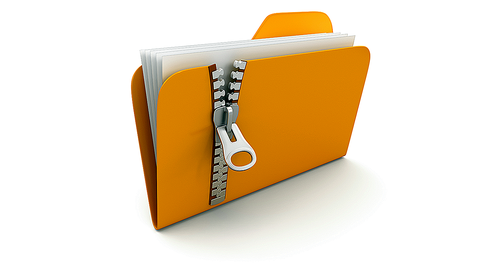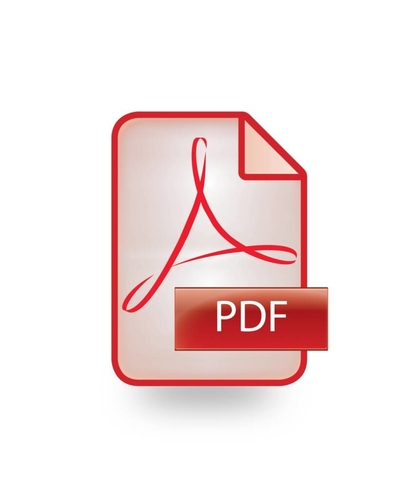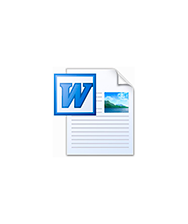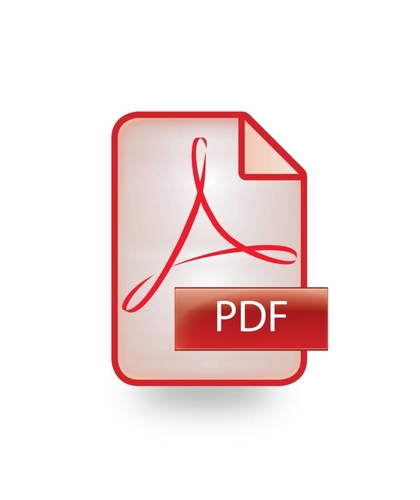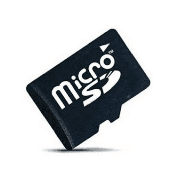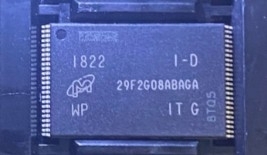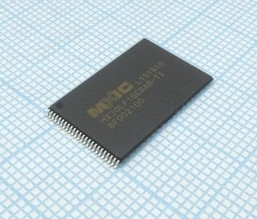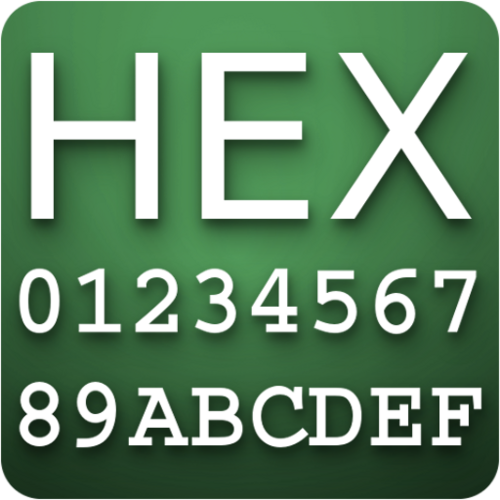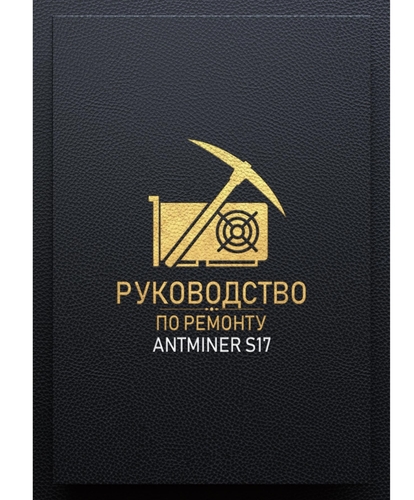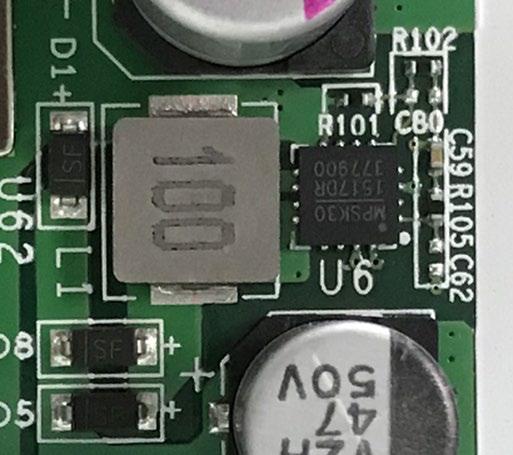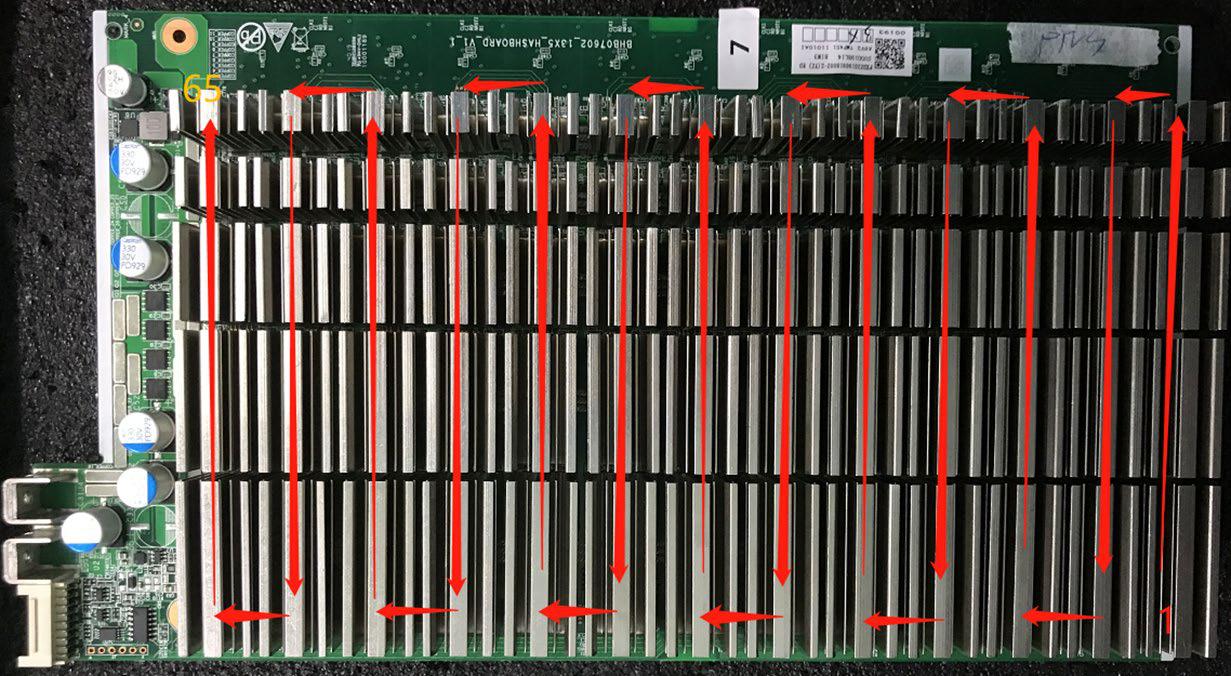Antminer S17 hash board Maintenance Guide
Date of the version: 2019.7.2
Document type: Repair plan
Content of this volume: It mainly describes the troubleshooting of S17 various faults, and explains how to use the test tools for accurate positioning.
※ The copyright of this article belongs to Bitmaintech Pte.Ltd. (Bitmain). The article shall solely be reprinted, extracted or used in any other ways with the permission of the copyright owner. Please contact Bitmain official customer service if there is any need of reprinting or quoting.
I. Service tools
1. General electric screwdriver
2. Fluke 15b+ Multimeter, Tweezers, V9-v1.2 test fixture, S17 chassis with APW9 power supply
3. Heat gun (welding temperature is 260±2 degrees). Note: the temperature marked here is the actual temperature
4. Thermostat soldering iron (welding temperature is 300-350 degrees)
5. Environment-friendly scaling powder, lead-free low temperature (melting point 150 degrees) solder stick, anhydrous alcohol, water for cleaning panel;
6. OM550 low temperature solder paste, BM1397AE tin planting steel mesh fixture
7. Cooling fan;
If you need to repair Antminer S17, in addition to the necessary tools mentioned above, you also need general-purpose 862D-desoldering stations, tin scrapers and other efficient tools.
Of course, this choice may be more troublesome, you can also choose the convenient Bitmain Antminer hash board repair bundle.
II. Component structure of hash board
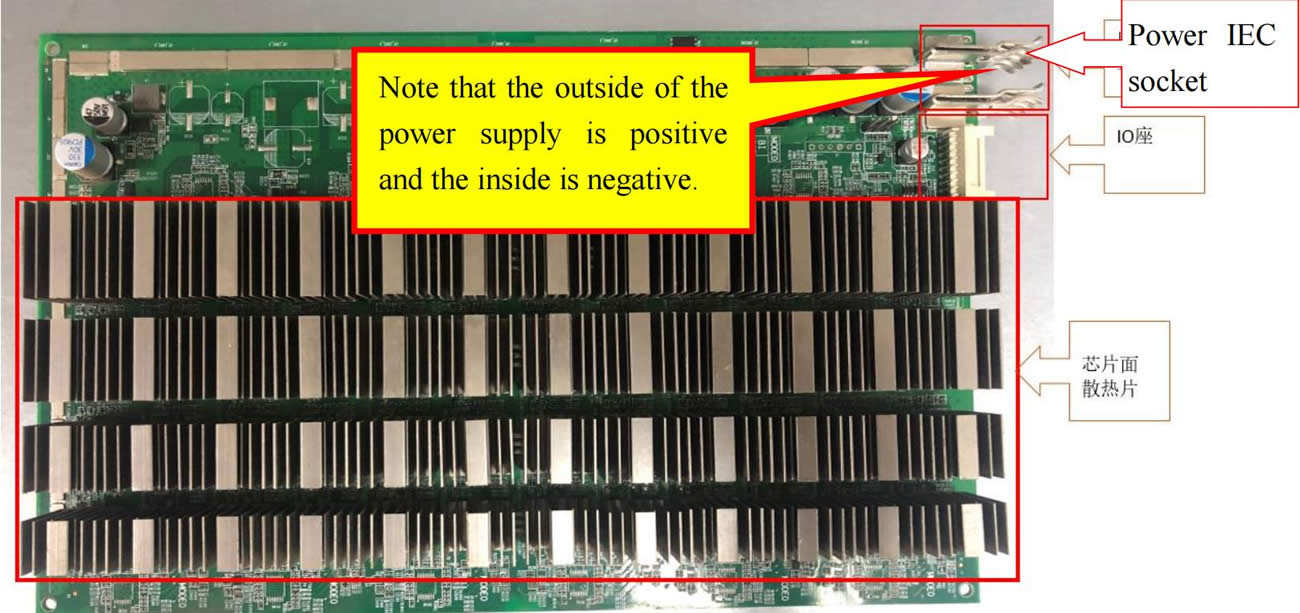
III. Signal transmission circuit
1. Signal transmission channel, the signal CLK-RST-BO-CO is transmitted from the first chip to the second one, until the 48th; RI signal is transmitted from the 48th chip to the first chip reversely, as shown in following figure:
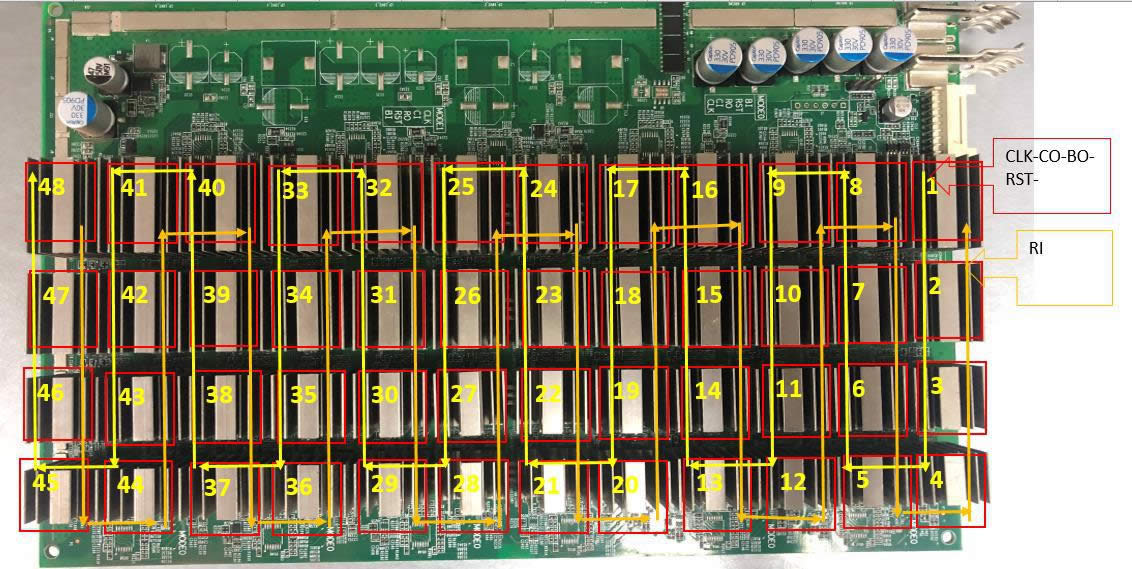
2. Signal test point identification and test point arrangement order (the hash board has a total of 48 chips, and 12 voltage domains) are as shown below:
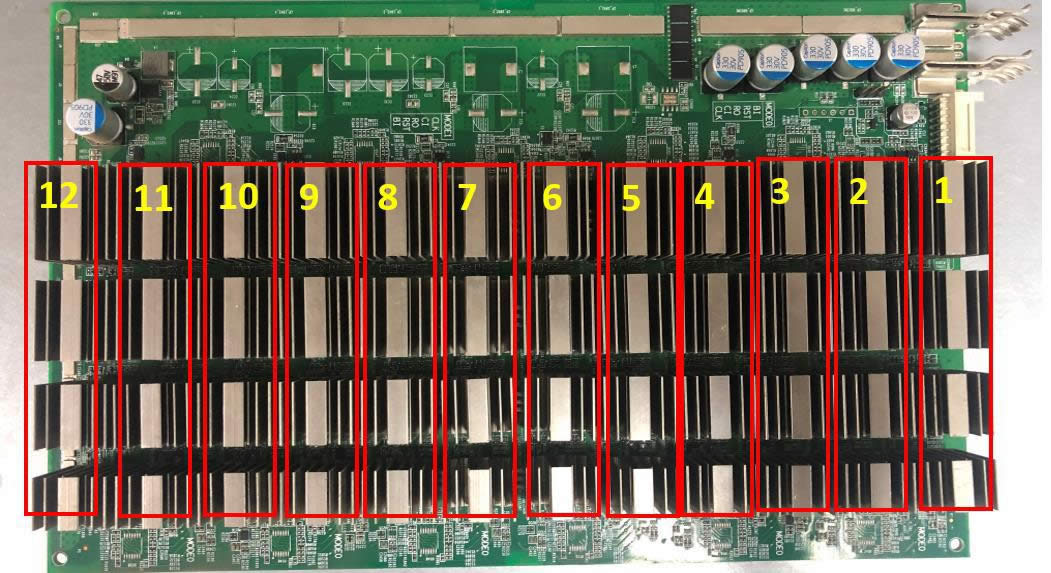
Distribution of voltage domain test points
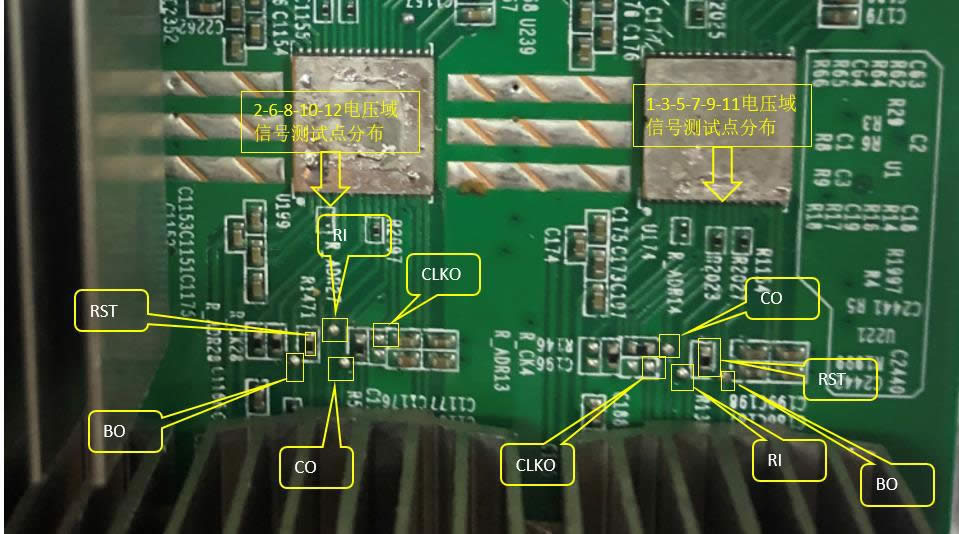
Picture of real product
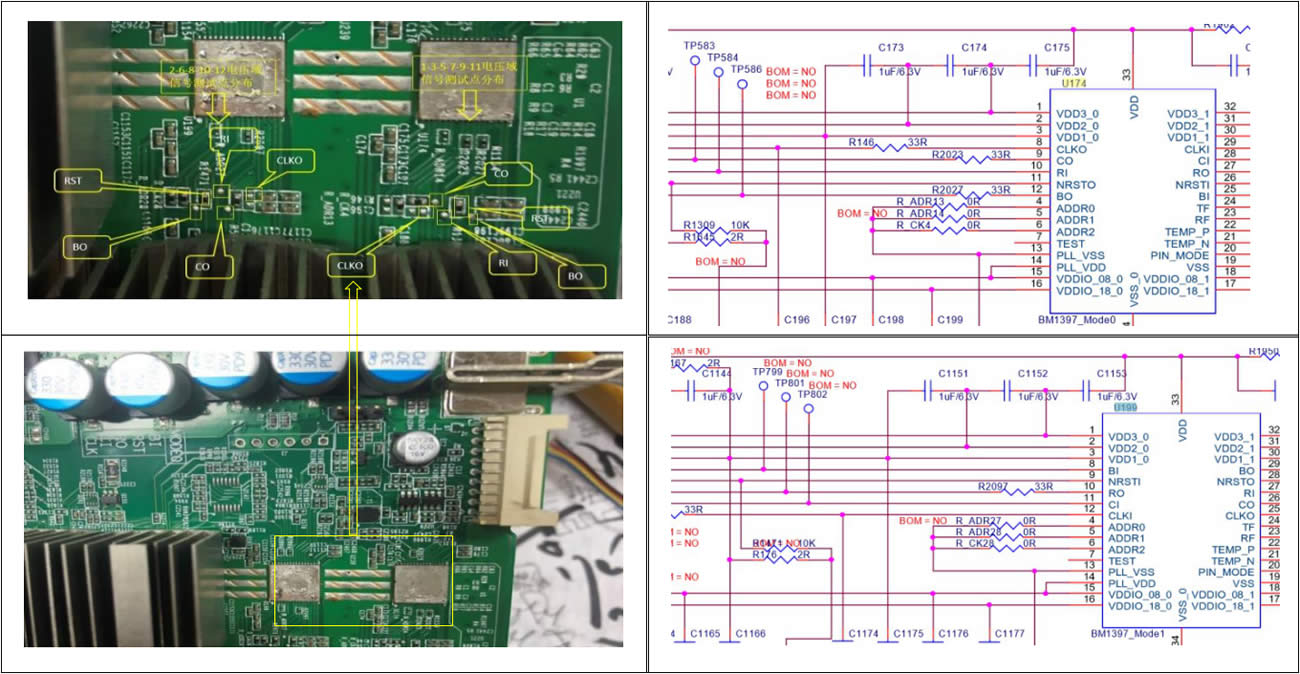
3.Signal communication circuit from IO block to chip
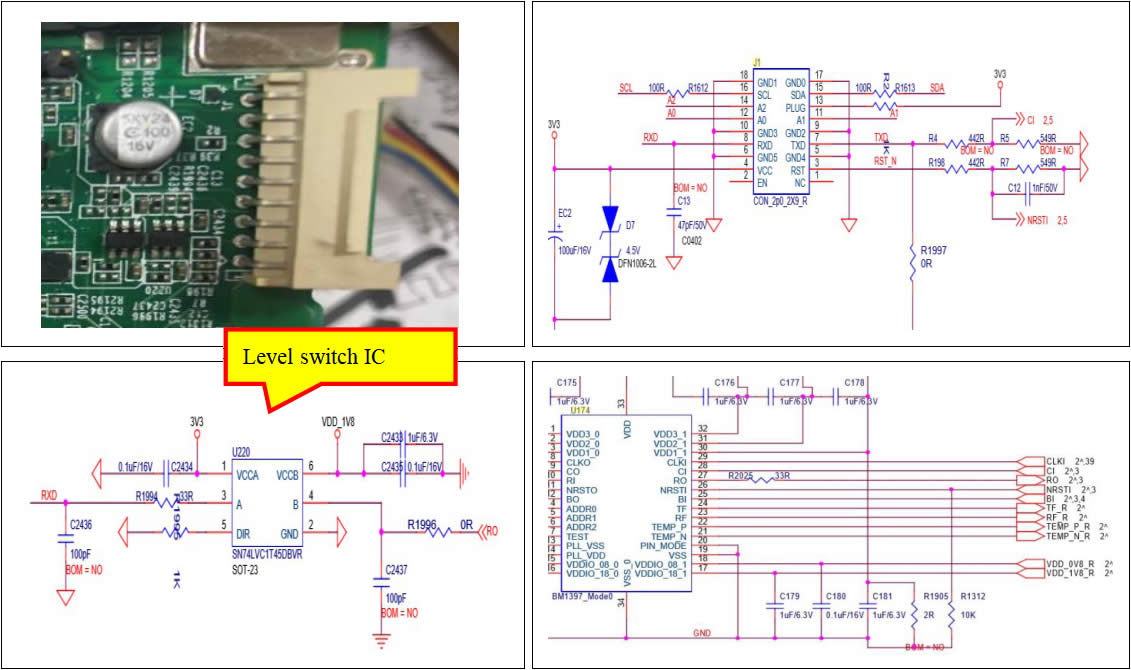
J1-IO block picture J1-IO block schematic diagram
IV. Power circuit
The power supply voltage of each board (S17 fixture test voltage output is 18.5V). There are 12 voltage domains, and the voltage of every two voltage domains is 1.55v.
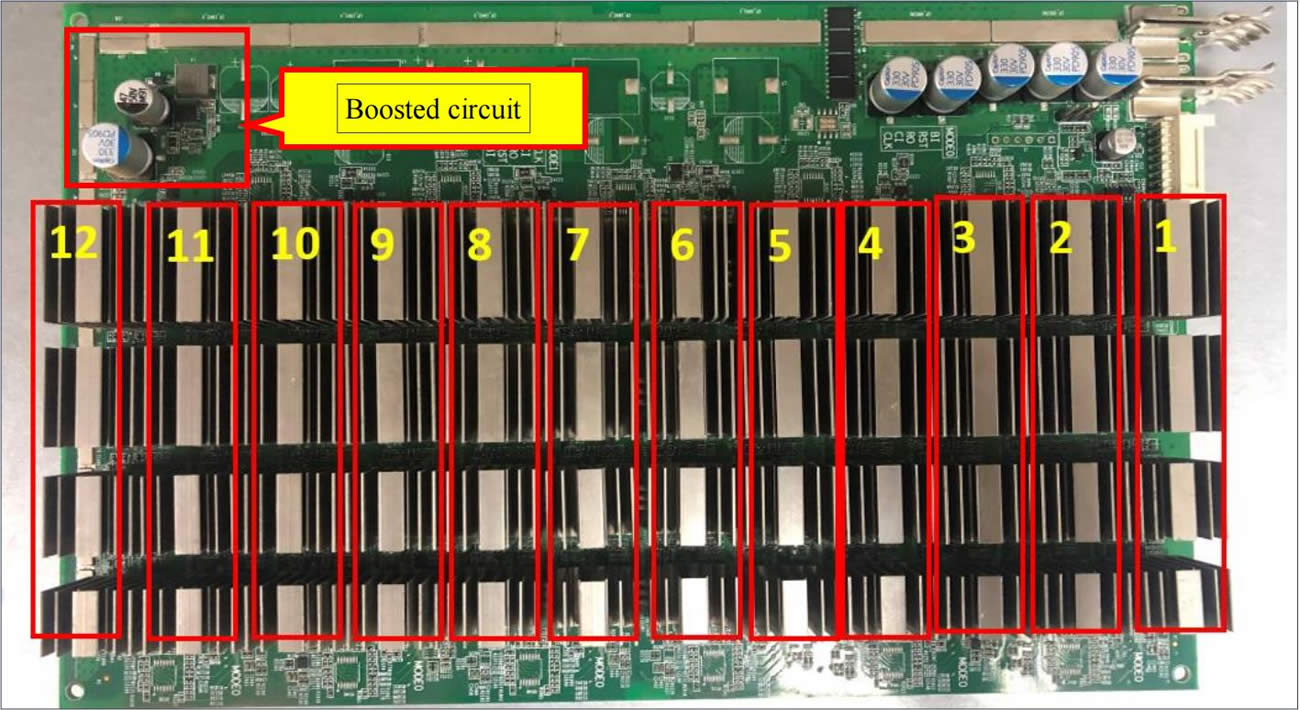
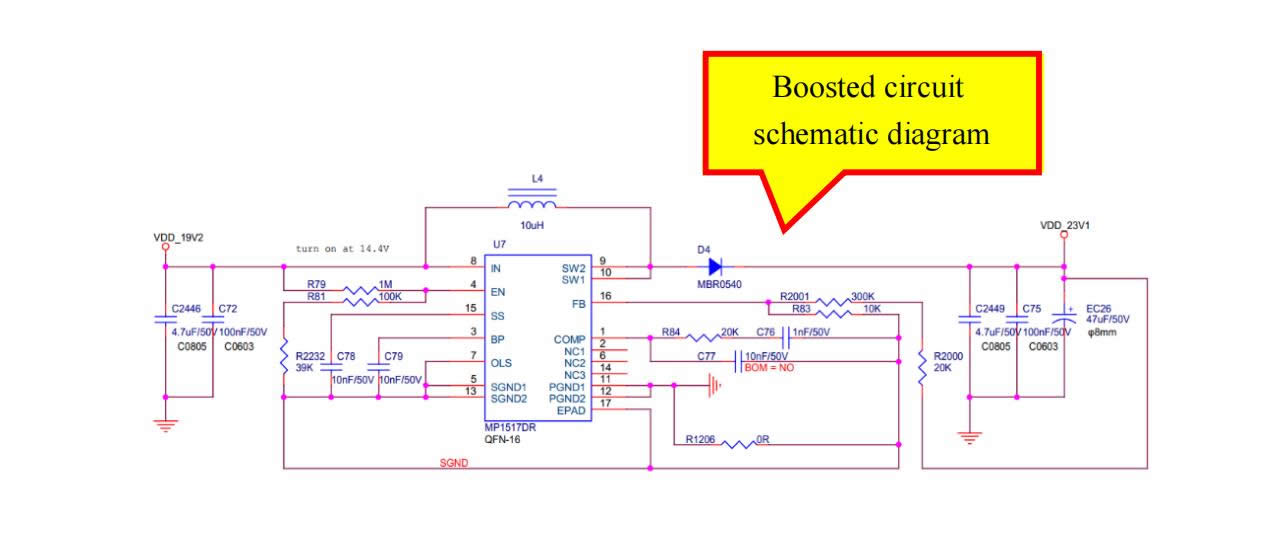
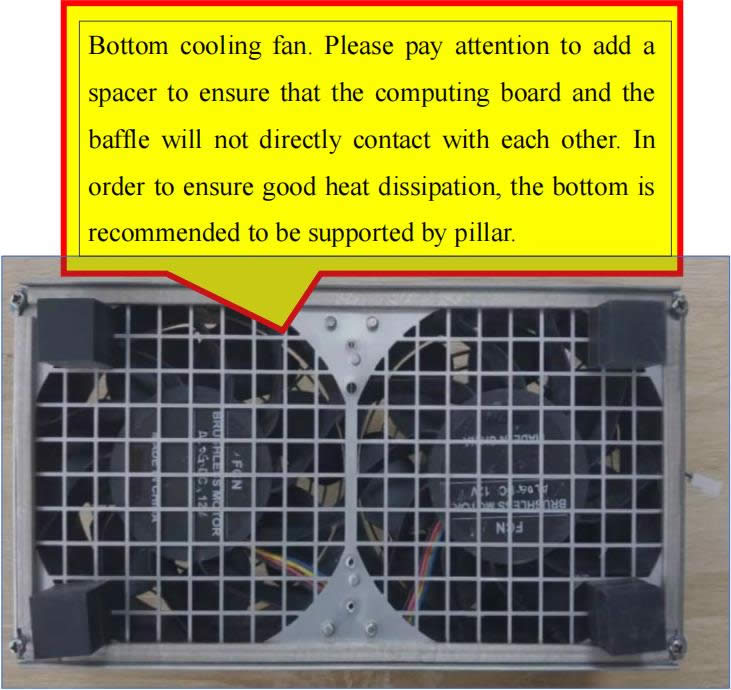
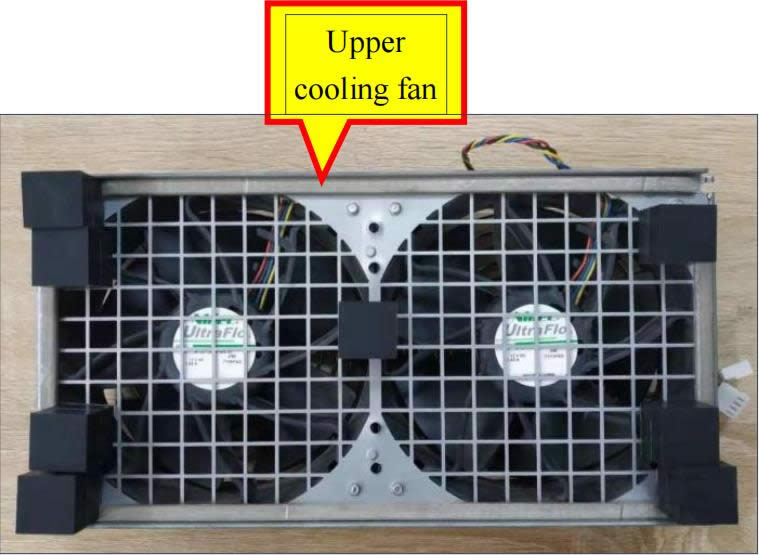
V. Considerations for single board test
1. The hash board is not attached with cooling fin. The fixture program can only adopt the chip test program. After the chip is found, the cooling fan is attached.
2. If the hash board needs to test parten, the heat dissipation requires 4 fans;
3. After sales, the miner in the condition of the software without sweeping frequency needs to change the repair mode under the fixture config file to 1, that is, the eeprom data is not cleared when testing;

VI. Single board test troubleshooting example
6. 1 single board fixture test ASIC=0
Failure analysis:
1. Whether the fixture cable and the hash board are in good contact.
2. If it’s the S17 hash board, J6-J7 should have a voltage of 18.5V when testing the fixture.
3. When the fixture test is performing, whether there is a voltage between the 12 voltage domains, and the boost circuit is normal:
3.1 If there is no voltage in the voltage domain, it is necessary to check that the normal working voltage of the 4 pin of Q7Q8Q9Q11 is 0V. If it is high level, then check whether the 1 pin of Q10 is high level 3.3v. If Q10 does not have a voltage of 3.3v, it indicates that the U3-PIC loses firmware or is not powered.

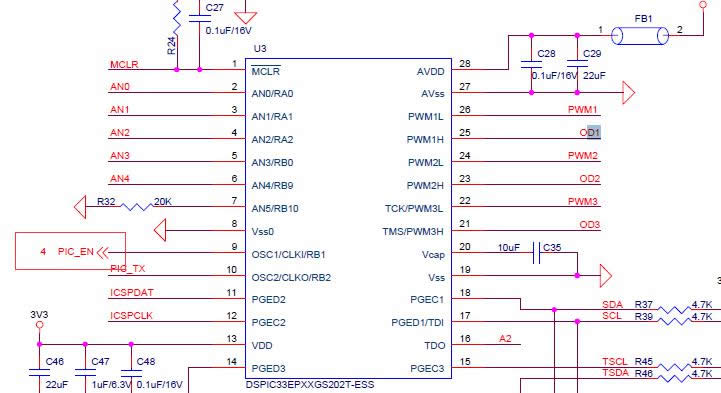
PIC schematic diagram
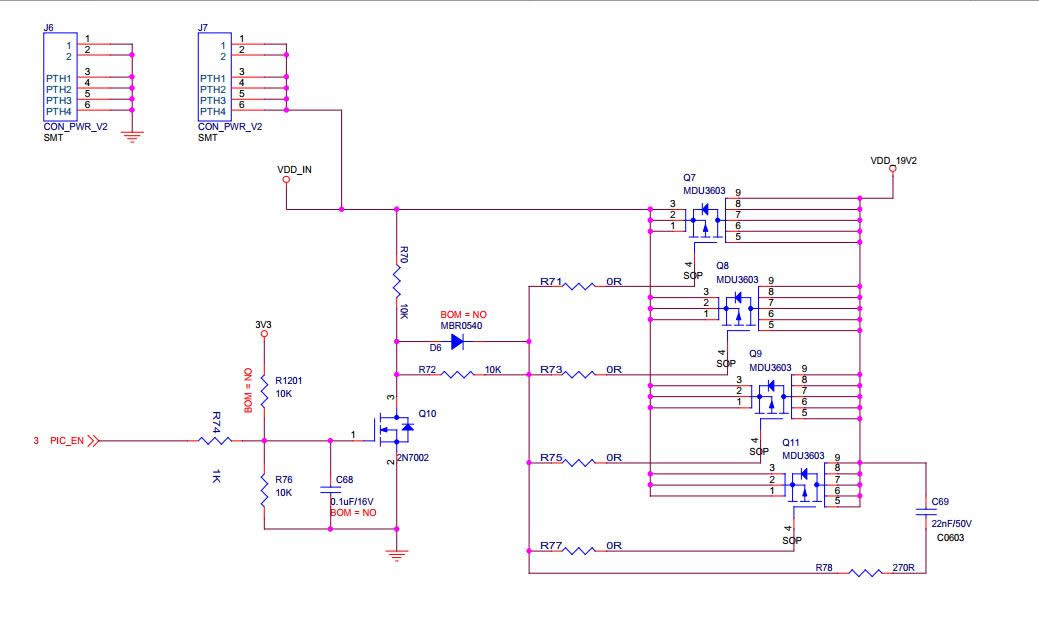
18.5V output control circuit
3.2 If the power supply is normal and the voltage of voltage domain is also available, then measure the RI signal of the chip to check if the RI signal has a voltage of 1.8V. When measuring the RI signal, it should be measured from the test point of the last chip, and if the last one has voltage, then measure the 20th chip for RI -1.8v. By analogy, when the chip has no RI output voltage is found, first measure it for the 1.8V power supply, if there is no power supply at 1.8V, then check the 1.8V power supply circuit. The 1.8V power supply circuit is obtained through voltage division by the voltage domain and then supply power to the LDO 1 pin. The LDO’s 5 pin outputs 1.8V, (each voltage domain has one 1.8V LDO supplying power for the chip). If there is no output, there should be a problem with this LDO. If 1.8V is normal, measure the resistance value over the ground of the test point after power is cut off, and compare with the OK board to check if there is any resistance abnormality. If the value is normal and there is no problem in soldering, it should be that the chip has a fault, (weld the removed chip on a good board after planting tin, and then verity it. If there is no RI signal, it proves that the chip is damaged, so please replace the chip).


5.2 Fault phenomenon ASIC=7
Analysis: ASIC=7,
1. Single board test can find 7 chips, indicating that the RI signal is normal. The 8th chip cannot be found, so we shall directly measure the voltage of the 7th chip U198-CLK-RST-CO to check if the power supply is normal. If CLK does not have a voltage of 0.8V, then check the power supply circuit of CLK.
2. CLK circuit analysis: If CLK does not have 0.8V, first check whether the bad chip voltage domain 0.8V power supply is normal. The 0.8V power supply circuit is obtained by voltage domain divider and then supply power in the same way as 1.8V power supply mode. 5 pin output 0.8V maintenance method can refer to the 1.8V maintenance method (note that every two chips among the 4 chips of each domain of S17 can provide 0.8V LDO power supply, and every LDO supplies 2 chips)


0.8v power supply scheme
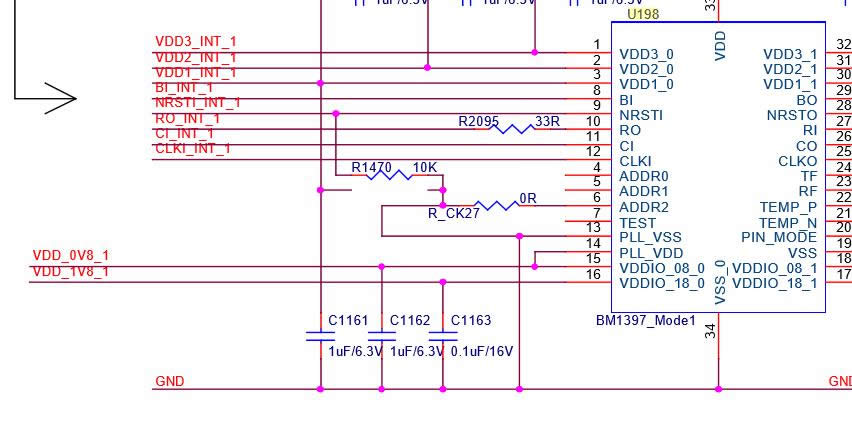
If the 0.8V power supply circuit does not have a 0.8V output, then check if the 0.8V LDO power supply has a supply voltage of about 3.2V. If so, check whether the LDO is cold solder joint or short-circuited. If there is a 0.8V output, check the resistance of the chip over the ground. If the resistance is correct, it indicates the chip is damaged.
По вопросам приобретения продукции обращайтесь к нашему менеджеру по продажам: [email protected]
По вопросам ремонта майнера и послепродажного обслуживания обращайтесь к менеджеру по ремонту: [email protected]
По вопросам делового сотрудничества обращайтесь: [email protected]
ЖАЛОБЫ И ПРЕДЛОЖЕНИЯ
Если вы недовольны транзакцией или у вас есть ценные предложения для нас, свяжитесь с нами по этому адресу электронной почты: [email protected]
12 файлов
-
Сортировка
-
Фильтр
-
100 ₽
Инструкция по редактированию EEPROM antminer 17 cерии
Автор:
bma37
Возможно уже не особо актуальная инструкция ну пусть будет может кому-то пригодится. Знаю что есть скрипт, который автоматом все это делает. Так же в группе человек выкладывал программу по редактированию eeprom, но только для T17e -https://t.me/pro_repair_miners/174015 . Возможно стоит его попросить чтобы он добивал в нее другие модели и выложил на форум. И тогда необходимость ручной правки eeprom отпадет совсем. Плата символическая на оплату хостинга.
2 покупки
2 скачивания
-
Бесплатный
Прошивка для тестов S17 — S17PRO
Автор:
Kowex
ВАЖНО!
При применении тестера, тестер затирает информацию с ээпромки которая находится на хешплате. Прежде чем прогонять плату тестером, сохраните прошивку ээпром с платы. Если вы всё же затерли прошивку с платы то, скопируйте прошивку с соседней платы этого же майнера и залейте в него.
Лично я сделал переходник для программатора минипро и подав питание 3.3 вольта, считываю и заливаю прошивку как 24С02, смотрите фото.
Теперь по поводу тестера. Подключите по ТХ и РХ ТТЛ переходник на контрольную плату майнера. Откройте программу putty и введите порт ТТЛ переходника. Распаковываете архив тестера на СД карту, вставляйте и запустите контрольную плату и после чего в putty можете отследить как загружается инфо с карточки. После загрузки можете нажимать на кнопку IP ресет на контрольной плате и плата выполнит одну проверку хешплаты. Одно нажатие на кнопку IP, одна проверка. Не забудьте подать питание 21 вольт на хешплату с лабораторного блока питания примерно с мощностью на 8 ампер.
Спасибо Сергею https://t.me/pro_repair_miners/40368
55 скачиваний
(0 обзоров)
0 комментариев
Обновлено 22 Января 2022
-
Бесплатный
инструкция
Инструкции по ремонту плат S17 — S17Pro
Автор:
Kowex
Инструкции по ремонту плат S17 — S17Pro
58 скачиваний
(0 обзоров)
0 комментариев
Обновлено 20 Января 2022
-
150 ₽
инструкция
Инструкция по ремонту плат S17 — S17Pro (редакция от Sergey)
Автор:
Sergey
Инструкция по ремонту плат S17 — S17Pro
С переводом и моими картинками
Оплата символическая в виде доната.
40 покупок
141 скачивание
(0 обзоров)
0 комментариев
Обновлено 6 Февраля 2022
-
Бесплатный
инструкция
Инструкция по ремонту плат S17 — S17Pro
Автор:
Kowex
Инструкция по ремонту плат S17 — S17Pro
118 скачиваний
(0 обзоров)
0 комментариев
Отправлено 20 Января 2022
-
100 ₽
Восстановление CPU после замены, через SD S17
Автор:
bot
Восстановление CPU контрольной платы после замены, через SD S17
Оплата символическая в виде доната.
5 покупок
9 скачиваний
(0 обзоров)
0 комментариев
Обновлено 24 Марта 2022
-
100 ₽
dump
Дамп памяти контрольной платы под флешку MT29F2G08ABAGAWP
Автор:
Sergey
Дамп памяти под MT29F2G08ABAGAWP
S17
Оплата символическая в виде доната.
8 покупок
13 скачиваний
(0 обзоров)
0 комментариев
Обновлено 10 Февраля 2022
-
200 ₽
Дамп памяти контрольной платы S17/T17/S17+ и тд. для MX30LF2GE8AB
Автор:
Sergey
Дамп контрольки для прошивки через программатор
1 покупка
5 скачиваний
(0 обзоров)
0 комментариев
Обновлено 14 Февраля 2022
-
Бесплатный
eprom
s17_eeprom_dump
Автор:
Canned_Heat
Дамп считанный программатором с микросхемы eeprom хэш платы S17.
31 скачивание
-
sd , тестовая прошивка s17-t17 авто опрос
Автор:
x888HIM888x
8 покупок
14 скачиваний
(0 обзоров)
0 комментариев
Отправлено 22 Июня 2022
-
DSPIC33EP16GS202-s17.hex
Автор:
вадим vadim
прошивка PIC контролера s17
11 скачиваний
(0 обзоров)
0 комментариев
Отправлено 23 Июня 2022
-
150 ₽
Мануал по ремонту s17
Автор:
Artoym_Belov
Мануал по ремонту 17-ой серии. Нумерация чипов, какие чипы используются, контрольные точки, диагностика, проверка работоспособности чипов, оборудование для ремонта, тех. процесс. 13 страниц (включая обложку)
9 покупок
21 скачивание
(0 обзоров)
0 комментариев
Отправлено 16 Августа 2022
Скачать и просмотреть руководство по ремонту, запуску и обслуживанию асик майнеров AntMiner, Whatsminer, Innosilicon, Avalon онлайн
На этой странице вы можете прочесть и скачать все необходимые руководства.
Но, конечно, вы всегда можете связаться с нами по WhatsApp +79275104327, по электронной почте Этот адрес электронной почты защищен от спам-ботов. У вас должен быть включен JavaScript для просмотра. или оставить сообщение в чате, если у вас есть какие-либо (технические) вопросы о наших продуктах.
Руководство по ремонту [PDF] Antminer
Руководство по ремонту хэш-платы Antminer D3
Руководство по ремонту хэш-платы Antminer S9
Руководство по ремонту хэш-платы Antminer S9K
Руководство по ремонту хэш-платы Antminer S11
Руководство по ремонту хэш-платы Antminer S15 T15
Руководство по ремонту хэш-платы Antminer S17+
Руководство по ремонту хэш-платы Antminer S17E
Руководство по ремонту хэш-платы Antminer S17
Руководство по ремонту хэш-платы Antminer T9
Руководство по ремонту хэш-платы Antminer T17+
Руководство по ремонту хэш-платы Antminer T17
Руководство по ремонту хэш-платы Innosilicon miner
Руководство по ремонту хэш-платы Antminer WhatsMiner M10
Руководство по ремонту хэш-платы Antminer Whatsminer M20S
Инструкция по установке [PDF]
Antminer
Руководство Antminer D3
Руководство Antminer DR3
Руководство Antminer DR5
Руководство Antminer E3
Руководство Antminer L3
Руководство Antminer R4
Руководство Antminer S1
Руководство Antminer S2
Руководство Antminer S3
Руководство Antminer S4+
Руководство Antminer S5+
Руководство Antminer D3
Руководство Antminer S7
Руководство Antminer S9 Hydro
Руководство Antminer S9
Руководство Antminer S9k
Руководство Antminer S9SE
Руководство Antminer S11
Руководство Antminer S15
Руководство Antminer S17+
Руководство Antminer S17E
Руководство Antminer S17
Руководство Antminer S17Pro
Руководство Antminer T17
Руководство Antminer S19
Руководство Antminer S19Pro
Руководство Antminer T9
Руководство Antminer T15
Руководство Antminer T17+
Руководство Antminer T17E
Руководство Antminer T19
Руководство Antminer X3
Руководство Antminer Z9 Mini
Руководство Antminer Z9
Руководство Antminer Z11
Руководство Antminer Z15
Avalon
Avalonminer 1047 Manual
Avalonminer 1066 Manual
Avalonminer 1026 Manual
Avalonminer 1066 Pro Manual
Avalonminer 1146 Pro Manual
Innosilicon
Innosilicon A4+Manual
Innosilicon A6 Manual
Innosilicon A9 Manual
Innosilicon D9 DCR Manual
Innosilicon S11 Sia Manual
Innosilicon T2T 32T Manual
Innosilicon T2TZ 30T Manual
Innosilicon T3+57T Manual
Loveminer
Loveminer A1 Manual
Whatsminer
WhatsMiner D1 Manual
WhatsMiner M3 Manual
WhatsMiner M10 Manual
WhatsMiner M20S Manual
WhatsMiner M21 Manual
WhatsMiner M21S Manual
WhatsMiner M30S Manual
WhatsMiner M31S Manual
WhatsMiner M32 Manual
руководство по блоку питания и руководство по ремонту [PDF]
Руководство Antminer APW3
Руководство Antminer APW5
Руководство по ремонту блоков питания Antminer APW9 и APW9+
Руководства по Antminer, ремонт antminer , ремонт whatsminer, ремонт innosilicon, ремонт avalon, руководство по ремонту асиков
Руководство по ремонту [PDF]
Antminer
- Руководство по ремонту хэш-платы Antminer D3
- Руководство по ремонту хэш-платы Antminer S9
- Руководство по ремонту хэш-платы Antminer S9 K
- Руководство по ремонту хэш-платы Antminer S11
- Руководство по ремонту хэш-платы Antminer S15 T15
- Руководство по ремонту хэш-платы Antminer S17+
- Руководство по ремонту хэш-платы Antminer S17E
- Руководство по ремонту хэш-платы Antminer S17
- Руководство по ремонту хэш-платы Antminer T9
- Руководство по ремонту хэш-платы Antminer T17+
- Руководство по ремонту хэш-платы Antminer T17
- Руководство по ремонту хэш-платы Innosilicon miner
- Руководство по ремонту хэш-платы Antminer WhatsMiner M10
- Руководство по ремонту хэш-платы Antminer Whatsminer M20S
Инструкция по установке [PDF]
Antminer
- Руководство Antminer D3
- Руководство Antminer DR3
- Руководство Antminer DR5
- Руководство Antminer E3
- Руководство Antminer L3
- Руководство Antminer R4
- Руководство Antminer S1
- Руководство Antminer S2
- Руководство Antminer S3
- Руководство Antminer S4+
- Руководство Antminer S5+
- Руководство Antminer D3
- Руководство Antminer S7
- Руководство Antminer S9 Hydro
- Руководство Antminer S9
- Руководство Antminer S9 k
- Руководство Antminer S9 SE
- Руководство Antminer S11
- Руководство Antminer S15
- Руководство Antminer S17+
- Руководство Antminer S17 E
- Руководство Antminer S17
- Руководство Antminer S17 Pro
- Руководство Antminer T17
- Руководство Antminer S19
- Руководство Antminer S19 Pro
- Руководство Antminer T9
- Руководство Antminer T15
- Руководство Antminer T17+
- Руководство Antminer T17 E
- Руководство Antminer T19
- Руководство Antminer X3
- Руководство Antminer Z9 Mini
- Руководство Antminer Z9
- Руководство Antminer Z11
- Руководство Antminer Z15
Avalon
- Avalonminer 1047 Manual
- Avalonminer 1066 Manual
- Avalonminer 1026 Manual
- Avalonminer 1066 Pro Manual
- Avalonminer 1146 Pro Manual
Innosilicon
- Innosilicon A4+Manual
- Innosilicon A6 Manual
- Innosilicon A9 Manual
- Innosilicon D9 DCR Manual
- Innosilicon S11 Sia Manual
- Innosilicon T2T 32T Manual
- Innosilicon T2TZ 30T Manual
- Innosilicon T3+57T Manual
Loveminer
- Loveminer A1 Manual
Whatsminer
- WhatsMiner D1 Manual
- WhatsMiner M3 Manual
- WhatsMiner M10 Manual
- WhatsMiner M20S Manual
- WhatsMiner M21 Manual
- WhatsMiner M21S Manual
- WhatsMiner M30S Manual
- WhatsMiner M31S Manual
- WhatsMiner M32 Manual
руководство по блоку питания и руководство по ремонту [PDF]
- Руководство Antminer APW3
- Руководство Antminer APW5
- Руководство по ремонту блоков питания Antminer APW9 и APW9+
Referring to how to troubleshoot the Bitmain Antminer S17+ hashboard, and explains how to use the Antminer test fixture sold by ThanosMining for accurate positioning.
New version of test fixture: Antminer S17+ test fixture
I. Maintenance Platform / Tool Preparation
1. Platform requirements: rubber sheet maintenance workbench (workbench needs to be grounded), anti-static wrist strap and grounding.
2. Constant temperature soldering iron (350–360℃), the head of tip soldering iron is used to solder small patches such as chip resistors and capacitors, etc.; heat gun, BGA rework station for chip / BGA disassembly and soldering; multimeter, soldering steel pin and shrink tubing for easy measurement (Fluke recommended); oscilloscope (Agilent recommended)
3. Testing tool requirements: APW9 + power supply and power patch cord for power supply of hashboard; 2.1040 control board, hashboard tester.
4. Requirements for maintenance auxiliary materials / tool: low-temperature solder paste Alpha OM550, flux, water for cleaning panel and anhydrous alcohol; water for cleaning panel is used to clean up soldering residues after repair; thermal conductive paste is used to apply on chips / heat sinks after maintenance (some models require thermal conductive paste); tin-planting steel mesh, ball-planting steel mesh, solder wire, solder ball (ball diameter is recommended to be 0.4mm); when replacing a new chip, you need to plant tin on chip pin and the BSM surface before soldering them to the hashboard.
5. Demand for common maintenance spare materials: 0402 resistance (0R, 33R, 1K, 4.7K,); 0201 resistance (0R),0402 capacitor (0.1uf, 1uf)
II. Operation Requirements
1. Maintenance personnel must have certain electronic knowledge, more than one year of maintenance experience, and be proficient in BGA / QFN / LGA package soldering technology.
2. After repairing, the hashboard must be tested to be OK for more than twice, otherwise, it shall be rejected.
3. Please pay attention to the operation method when replacing the chip. There should be no obvious deformation of the PCB board after replacing any accessories. Check whether there are any open or short circuits, or missing parts in the replacement parts and the surroundings.
4. Check the tools, confirm whether the test fixtures can work normally, determine the test software parameters for the maintenance station, and version of test fixtures, etc.
5. After passing the repair and replacement chip test, you need to check the full chip before performing the functional test. The functional test shall ensure that the double-sided heat sinks are soldered OK and the cooling fan is at full speed. When using the chassis cooling function, you must put 3 hashboards at the same time to form air duct. The single-sided test of production must also ensure the formation of air ducts (important).
6. When measuring the signal, two fans are used to dissipate heat as assistance measure, and the fans maintain full speed.
7. For the front and back of the hashboard, the steel windshield is under 21V voltage. During the measurement and maintenance, please keep the maintenance table clean and insulated to avoid short circuit during the maintenance.
8. When replacing a new chip, apply solder paste on the pins and the BSM surface to ensure that the chip is pre-tinned before soldering to PCBA for maintenance.
9. Fixtures at the maintenance end adopt Repair_Mode mode and config configuration files tested in non-scanning mode. After passing the test, the production end starts the production line from test piece; the after-sale end is normally installed and aged (installed at the same level). The test configuration file can be obtained from TE.
III. Production of Hashboard Tester and Precautions
The supporting clamps of hashboard tester should meet the requirements for heat dissipation of the hashboard and facilitate the measurement of signals.
1. Calibrate the hashboard tester.
2. Use the test fixture SD card flash program to update the control board FPGA. After decompression, copy to the SD card and insert the card into the fixture card slot. Power on for about 1 minute and wait for the control board indicator to flash for 3 times, then complete the update.
Figure 3-1
Figure 3-2
3. The test SD card will be produced according to the requirements. The single-sided heat sink uses the file before brushing to make the SD card; the double-sided heat sink uses the file after brushing to make the SD card.
Figure 3-3
4. The double-sided test at the production end requires a code scanning gun and serial port tools. Please refer to the test process file for details.
5. The after-sale end and outsourced maintenance side does not need to use the code scanning method (hashboard tester SD card configuration file needs to be changed, the demand can be submitted to TE and TE will test the config configuration file for hashboard tester).
IV. Principle Overview
1. S17+ hashboard working structure:
The hashboard is composed of 65 BM1397 chips, which are divided into 13 groups, each group is composed of 5 ICs; the working voltage of the BM1397 chip used by the S17 hashboard is 1.5V; the last 24.5V output by the boost circuit U6 powers the LDO, LDO outputs 1.8V, the last third and third groups are powered by 24.5V DCDC to output 1.8V, and the other groups are powered by 21V divided voltage to provide 1.8V through DCDC. All 0.8V is provided by the 1.8V of this domain via the LDO output, as shown in Figure 4-1.
Figure 4-1
2. S17 hashboard boost circuit:
The boost is from 21V to 24.5V powered by the power supply, as shown in Figure 4-2.
Figure 4-2
3. S17 chip signal direction:
3.1 CLK (XIN) signal direction: It is generated by Y1 25M crystal oscillator and transmitted from chip 01 to chip 65. During operation, the voltage is 1.45-1.65V(oscilloscope). Voltage measured by multimeter is about 0.7-0.9V.
3.2 TX (CI, CO) signal direction: input from pin 7 (3.3V) of IO port, transferred to IC U2 through level conversion, then transmitted from chip 01 to chip 65; the voltage is 0V when the IO line is not inserted, and the voltage during operation is 1.8V.
3.3 RX (RI, RO) signal direction: from chip 65 to chip 01, return to pin 8 of the signal cable terminal via U1 and return to the control board; the voltage is 0.3V when the IO line is not inserted, and the voltage during operation is 1.8V.
3.4 BO (BI, BO) signal direction: from chip 01 to chip 65; voltage measured using multimeter is 0V.
3.5 RST signal direction: input from pin 3 of the IO port, and then transmitted from chip 01 to chip 65; 0V without IO signal or in standby and 1.8V in operation.
Figure 4-3
4. Overall architecture:
1. The machine is mainly composed of 3 hashboards, 1 control board, APW9 + power supply, and 4 cooling fans, as shown in Figure 4-4.
Figure 4-4
V. Common Poor Phenomenon of Hashboard and Troubleshooting Procedure
Phenomenon: during single board test, chip is detected to be 0 (PT1 / PT2 station type)
Step one: check the power output first. Please check the circled part in Figure 5-1.
Figure 5-1
Step two: check the voltage domain voltage output
The voltage in each voltage domain is about 1.6V. Generally, there is a domain voltage when power is supplied at 21V. It is preferred to measure the output of the power supply terminal of the hashboard and determine whether the MOS is shorted (measure the resistance between pins 1, 4, and 8). If there is power supply at 21V but no domain voltage, continue to check downward.
Figure 5-2
Step three: check the PIC circuit
Measure whether the second pin of U3 has an output, the voltage is about 3.2V; if yes, please continue to troubleshoot, if there is no 3.3V, please check that the connection status of the fixture cable and the hashboard is OK, and re-program the PIC.
Figure 5-3
Figure 5-4
Figure 5-5
PIC programming procedure:
1. Program the PIC program of the arithmetic board.
Procedure: 20190908-PIC1704-BHB07602-0x88.hex
Download the programming tool: PICkit3; pin 1 of the PICkit3 cable corresponds to pin 1 of J3 on the PCB, and pins 1, 2, 3, 4, 5, and 6 need to be connected.
Figure 5-6
2. Programming software:
Open MPLAB IPE, select device: PIC16F1704, click power to select the power supply method, and then click operate. First step: select the file to find the .HEX file to be programmed. Second step: click connect to connect normally. Third step: click the program button, then click verify after finish. Prompt will be sent to prove that the programming is successful.
Figure 5-7
Figure 5-8
Step four: check the boost circuit output
Test D5 / D8 in chart 5-9 to measure 23-24.5V voltage.
Figure 5-9
Step five: check the LDO 1.8V or PLL 0.8V output of each group
Figure 5-10
Step six: check the chip signal output (CLK / CI / RI / BO / RST)
Refer to the range of voltage values described by the signal direction. If the measurement encounters a large deviation in voltage value, it can be compared with the measured values of adjacent groups.
Figure 5-11
Assuming that the chip signal pin output voltage is normal, if the chip is still incomplete, for example, if 64 chips are detected, you can troubleshoot by shorting RO pull-up resistor R639. If 64 chips can be detected after shorting, it indicate that chips 1-64 should be normal, and you can troubleshoot the 65th chip at this time. If 63 chips are detected after short-circuiting, conduct troubleshooting forward; it is recommended to adopt the dichotomy method for troubleshooting, that is, test from the middle (starting from the 32th).
Figure 5-12
Troubleshooting comparison table:
Table 1
2. Phenomenon: Single board detection chip is incomplete (PT1 / PT2 station)
Check the relevant signals (CLK / CI / RI / BO / RST) of the chip in front of and behind the error position, locate the bad position according to the IC with the abnormal signal measured, and refer to the signal direction and voltage range for repair.
3. Phenomenon: single board pattern NG, that is, the response nonce data is incomplete (PT2 station type)
The serial port is connected to the computer, and the computer reads the test log; according to the results displayed in the log, the chip position of insufficient nonce data can be determined; replace the chip at the corresponding position.
4. Phenomenon: Test temperature reading is abnormal (PT2 station)
Check the temperature-sensing power supply VDD and the connection status between the temperature-sensing and the chip (TEMP_P; TEMP_N), and check the soldering quality of the chip connected to the corresponding temperature-sensing.
Figure 5-13
Figure 5-14
Check the quality of the front and back chip heat sinks connected to the temperature sensor. If the heat sink is not welded well, it will affect the temperature difference.
VI. Problems Caused by Control Board Issues
1. The whole machine is not running
First step: check whether the voltages at several voltage output points are normal. You can disconnect U8 first if 3.3V short circuit. If the short circuit still exists, you can unplug the CPU for measurement. For other voltage abnormalities, replace the corresponding transformer IC in general.
Second step: if the voltage is normal, please check the welding status of DDR / CPU (X-RAY inspection on the production side).
Third step: try to update the flash program with the SD card.
Figure 5-15
2.The whole machine cannot find the IP
Probably the IP is not found due to abnormal operation. Refer to point 1 for troubleshooting. Check the appearance and soldering of the network port, network transformer T1, and CPU.
3. The whole machine cannot be upgraded
Check the appearance and soldering of the network port, network transformer T1, and CPU.
4.The whole machine fails to read the hashboard or has fewer chains
A. Check the cable connection
B. Check the parts of corresponding chain on the control board
C. Check the wave soldering quality of the pins and the resistance around the plug-in interface
Figure 6-2
VII. Whole Miner Problems
1. Initial test of the whole machine
With reference to the test process documents, the general problems are assembly process issues and control board process issues.
Common phenomena: IP is not detected, the number of fans is abnormal, and the chain is abnormal.
2. The whole machine sweeping frequency band
Low hashrate caused by aging: Check the hashrate deviation of the corresponding hashboard to see if there is a large difference in hashrate, and take out the hashboard with a large hashrate deviation for test maintenance.
Check whether there’s low average hashrate caused by the network interruption.
Large temperature difference caused by hashrate: check the aging environment; for the hashboard with high temperature, check the welding quality of the heat sink of the hashboard.
Aging machine protection: generally over-temperature protection is required, please control the aging environment temperature to be less than 40 degrees Celsius.
Figure 7-1
Less chain:
If one of the chains cannot be detected, disassemble the machine and test the corresponding hashboard; if it is determined that the hashboard is faulty, repair the hashboard; if it’s determined that the control board is faulty, repair the control board.
Figure 7-2
4. After-sales maintenance
Refer to the above troubleshooting steps for each station. For related test procedures and hashboard testers, please communicate with the after-sales engineer for details. After repair, please use non-scanning mode to test PT2.
VIII. Other Matters Needing Attention
Maintenance flowchart
Figure 8-1 Maintenance flowchart
• Routine test: first perform visual inspection on the hashboard to be repaired, observe whether the PCB is deformed or burnt. If yes, it must be handled first; check whether there are any parts with obvious burn marks, collision offset or missing parts, etc.; secondly, if no problem is found through visual inspection, the impedance of each voltage domain can be tested first to detect whether there is a short circuit or an open circuit. If yes, it must be handled first. Third, check whether the voltage of each domain is about 1.5V.
• After the routine test is OK (in general, the short-circuit test is necessary for the routine test to prevent the chip or other materials from being burned due to short circuit when the power is on), you can use the hashboard tester to perform chip detection, and determine the positioning based on the hashboard tester test results.
• According to the display result of the test fixture test, test the voltages of chip test points (CO / NRST / RO / XIN / BI), VDD0V8 and VDD1V8, etc. starting from the vicinity of the faulty chip.
• According to the signal direction (the RX signal is passed in the reverse direction (from chip 65 to 1), and several signals CLK CO BO RST are transmitted in the forward direction (from chip 1 to 65), find the abnormal fault point through the power supply sequence.
• When locating to the faulty chip, the chip needs to be re-soldered. The method is to add a flux around the chip (preferably no-clean flux), and heat the solder joints of the chip pins to a dissolved status, so as to promote the chip pins and the pads to re-run, then removing tin finally, thus achieving the effect of re-tinning. If the failure is the same after re-soldering, the chip shall be replaced directly.
• The repaired hashboard can be determined to be a good product if it passes the fixture tests for more than twice. For the first time, after the replacement of the accessories is complete, wait for the hashboard to cool down and perform fixture test, after passing, set it aside and then cool it down; for the second time, wait for a few minutes until the hashboard is completely cooled before testing.
• After the board is repaired, relevant maintenance / analysis records (requirements for maintenance reports: date, SN, PCB version, tag number, bad cause, bad liability attribution, etc.) should be prepared for feedback to production, after-sales, research and development departments.
• After the record is prepared, install the entire machine for conventional aging.
• Good products repaired at the production end should flow production from the first station of production (at least conduct the appearance inspection and start from the PT1 / PT2 test station)!
Your email address will not be published.Required fields are marked. *
-
#61
Как рекомендация к действию из доступного мне мануала, а то ещё придётся рассказать, что сами чипы они тоже имеют термоинтерфейс, и могут быть датчиками температур в том числе
-
F6471450-91A1-4339-85A2-1F38D8156A14.jpeg
940,7 КБ · Просмотры: 223
-
#62
Итак Доброго дня.
Прошил VNISH лог внизу.
Походу беда с датчиками температуры.
-
7-9-2021_13.16.txt
10,5 КБ · Просмотры: 58
-
#63
Как рекомендация к действию из доступного мне мануала, а то ещё придётся рассказать, что сами чипы они тоже имеют термоинтерфейс, и могут быть датчиками температур в том числе
А где взять этот мануал?
-
#64
Шёл вместе с моим обучением за 150К ₽… учился я в миасик центре… И явно им переплатил, раза эдак в два.
-
#65
Блин зачем я сюда зашёл, расстройство одно. Зачем я купил этот с 17…
-
#67
Вот что происходит. 2 плата показывает 40 чипов, с 3 то же какой то кошмар. Вот. А было так что поработала 1 плата, перезагрузил и стали все работать. А вот сегодня в другую розетку надо было переставить и опять вот такое.
-
#68
теперь вот так стало
-
Безымянный1.jpg
327,3 КБ · Просмотры: 138
-
#69
вот смотрите теперь вот так
-
Безымянный2.jpg
333,8 КБ · Просмотры: 140
-
#70
Нужен реболл двух плат, отвал
-
#71
а со стоковой прошивкой норм все было?
про этот мануал речь?
-
Antminer T17 Hash Board Repair Guide.pdf
1,3 МБ · Просмотры: 139
-
#72
вот смотрите теперь вот так
рестарт после отдыха, полчаса, пусть платы остынут, на горячую может не стартануть.
-
#73
Основная проблема 17ой серии — припой. Он очень быстро деградирует. Если поплыла хэш-плата — чипы по очереди будут выходить из строя, вылечишь одни — вылезут другие.
Мои пока работают при +5 +10 хорошо. Думаю, для них это самая комфортная температура — главное не допускать постоянных перепадов температуры — например, утром +10 гр, а днем +30 и так каждый день — будет деформация припоя. А вентиляторы у Т17, почти постоянно работают на максимуме вне зависимости от температуры.
Надо ли ставить т17+ боком на блок питания?
-
#74
Основная проблема 17ой серии — припой. Он очень быстро деградирует. Если поплыла хэш-плата — чипы по очереди будут выходить из строя, вылечишь одни — вылезут другие.
Мои пока работают при +5 +10 хорошо. Думаю, для них это самая комфортная температура — главное не допускать постоянных перепадов температуры — например, утром +10 гр, а днем +30 и так каждый день — будет деформация припоя. А вентиляторы у Т17, почти постоянно работают на максимуме вне зависимости от температуры.
Их боком ставить лучше?!
-
#75
Добрый день !
Подскажите почему автотюн иногда отключает хэш платы на s17 pro на прошивке VNISH ?
Да так отключает, что на другой прошивке платы так же остаются отключены.
Приходиться включать автотюн под другую нагрузку и ждать, что он их разблокирует, а потом останавливать автотюн и то он все равно сам потом включается.
Если кто сталкивался с такой проблемой сообщите решение проблемы пожалуйста.
Спасибо !
-
Скриншот 13-10-2021 124606.jpg
73,6 КБ · Просмотры: 85
-
Скриншот 13-10-2021 125636.jpg
123,7 КБ · Просмотры: 145
-
#76
а в ТП не пробовал сперва обратиться? за что ты им отчисляешь?
-
#77
а в ТП не пробовал сперва обратиться? за что ты им отчисляешь?
Спасибо !
-
#79
Подскажите пожалуйста, на какой припой лучше садить радиаторы на t17 и s17, запутался уже, информации разной много
-
#80
Подскажите пожалуйста, на какой припой лучше садить радиаторы на t17 и s17, запутался уже, информации разной много
Рекомендуют на этот.

